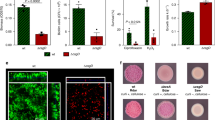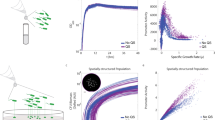Abstract
Colicins are narrow-spectrum antibiotics produced by and active against Escherichia coli and its close relatives. Colicin-producing strains cannot coexist with sensitive or resistant strains in a well-mixed culture, yet all three phenotypes are recovered in natural populations1. Recent in vitro results conclude that strain diversity can be promoted by colicin production in a spatially structured, non-transitive interaction2, as in the classic non-transitive model rock–paper–scissors (RPS). In the colicin version of the RPS model, strains that produce colicins (C) kill sensitive (S) strains, which outcompete resistant (R) strains, which outcompete C strains. Pairwise in vitro competitions between these three strains are resolved in a predictable order (C beats S, S beats R, and R beats C), but the complete system of three strains presents the opportunity for dynamic equilibrium2. Here we provide conclusive evidence of an in vivo antagonistic role for colicins and show that colicins (and potentially other bacteriocins) may promote, rather than eliminate, microbial diversity in the environment.
This is a preview of subscription content, access via your institution
Access options
Subscribe to this journal
Receive 51 print issues and online access
$199.00 per year
only $3.90 per issue
Buy this article
- Purchase on Springer Link
- Instant access to full article PDF
Prices may be subject to local taxes which are calculated during checkout



Similar content being viewed by others
References
Gordon, D. M., Riley, M. A. & Pinou, T. Temporal changes in the frequency of colicinogeny in Escherichia coli from house mice. Microbiology 144, 2233–2240 (1998)
Kerr, B., Riley, M., Feldman, M. & Bohannan, B. Local dispersal and interaction promote coexistence in a real life game of rock–paper–scissors. Nature 418, 171–174 (2002)
Fredericq, P. Colicins. Annu. Rev. Microbiol. 11, 7–22 (1957)
Hardy, K. G. Colicinogeny and related phenomena. Bacteriol. Rev. 39, 464–515 (1975)
Chao, L. & Levin, B. R. Structured habitats and the evolution of anticompetitor toxins in bacteria. Proc. Natl Acad. Sci. USA 78, 6324–6328 (1981)
Durrett, R. & Levin, S. Allelopathy in spatially distributed populations. J. Theor. Biol. 185, 165–171 (1997)
Gordon, D. M. & Riley, M. A. A theoretical and empirical investigation of the invasion dynamics of colicinogeny. Microbiology 145, 655–661 (1999)
Czárán, T. L., Hoekstra, R. & Pagie, L. Chemical warfare between microbes promotes biodiversity. Proc. Natl Acad. Sci. USA 99, 786–790 (2002)
Durrett, R. & Levin, S. Spatial aspects of interspecific competition. Theor. Popul. Biol. 53, 30–43 (1998)
Wadolkowski, E. A., Laux, D. C. & Cohen, P. S. Colonization of the streptomycin-treated mouse large intestine by a human fecal Escherichia coli strain: role of growth in mucus. Infect. Immun. 56, 1030–1035 (1988)
Hentges, D. J., Pongpech, P. & Que, J. How streptomycin treatment compromises colonization resistance against enteric pathogens in mice. Microb. Ecol. Health Dis. 3, 105–112 (1990)
Myhal, M., Laux, D. & Cohen, P. Relative colonizing abilities of human fecal and K-12 strain of Escherichia coli in the large intestines of streptomycin-treated mice. Eur. J. Clin. Microbiol. 1, 186–192 (1982)
Myhal, M., Cohen, P. & Laux, D. Altered colonizing ability for mouse large intestine of a surface mutant of a human faecal isolate of Escherichia coli. J. Gen. Microbiol. 129, 1549–1558 (1983)
Que, J. U., Casey, S. W. & Hentges, D. J. Factors responsible for increased susceptibility of mice to intestinal colonization after treatment with streptomycin. Infect. Immun. 53, 116–123 (1986)
Lau, C. Y. Y. Biology 89 (Yale Univ., New Haven, 1976)
Wilson, K. H. in Gastrointestinal Microbes and Host Interactions (eds Roderick, I., Mackie, B. A. W. & Isaacson R. E.) 680 (Chapman and Hall, New York, 1997)
Smith, M. Evolution and the Theory of Games (Cambridge Univ. Press, Cambridge, 1982)
Weibull, J. W. Evolutionary Game Theory (The MIT Press, Cambridge, Massachusetts, 1995)
Sweeney, N.-J. et al. The Escherichia coli K-12 gntP gene allows E. coli F-18 to occupy a distinct nutritional niche in the streptomycin-treated mouse large intestine. Infect. Immun. 64, 3497–3503 (1996)
Feldgarden, M. & Riley, M. A. The phenotypic and fitness effects of colicin resistance in Escherichia coli K-12. Evolution 53, 1019–1027 (1999)
Berry, R. J. Population dynamics of the house mouse. Symp. Zool. Soc. Lond. 47, 395–425 (1981)
Rowe, F. P. Wild house mouse biology and control. Symp. Zool. Soc. Lond. 47, 575–589 (1981)
Pugsley, A. P. Escherichia coli K-12 strains for use in the identification and characterization of colicins. J. Gen. Microbiol. 131, 369–376 (1985)
Dower, W., Miller, J. & Rasdale, C. High efficiency transformation of Escherichia coli by high voltage electroporation. Nucleic Acids Res. 16, 6127–6146 (1988)
Pugsley, A. P. & Oudega, B. in Plasmids, a Practical Approach (ed. Hardy, K. G.) 105–161 (IRL Press, Oxford, 1987)
Wald, A. Tests of statistical hypotheses concerning several parameters when the number of observations is large. Trans. Am. Math. Soc. 54, 426–482 (1943)
Author information
Authors and Affiliations
Corresponding author
Ethics declarations
Competing interests
The authors declare that they have no competing financial interests.
Rights and permissions
About this article
Cite this article
Kirkup, B., Riley, M. Antibiotic-mediated antagonism leads to a bacterial game of rock–paper–scissors in vivo. Nature 428, 412–414 (2004). https://doi.org/10.1038/nature02429
Received:
Accepted:
Issue Date:
DOI: https://doi.org/10.1038/nature02429
This article is cited by
-
Revisiting the Multifaceted Roles of Bacteriocins
Microbial Ecology (2024)
-
Transitivity and intransitivity in soil bacterial networks
The ISME Journal (2023)
-
The effect of territorial awareness in a three-species cyclic predator–prey model
Scientific Reports (2022)
-
Universal scaling of extinction time in stochastic evolutionary dynamics
Scientific Reports (2022)
-
Non-Hermitian topology in rock–paper–scissors games
Scientific Reports (2022)
Comments
By submitting a comment you agree to abide by our Terms and Community Guidelines. If you find something abusive or that does not comply with our terms or guidelines please flag it as inappropriate.



